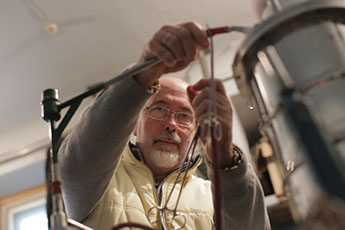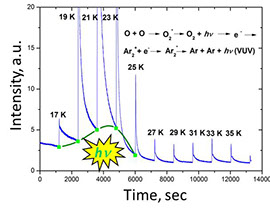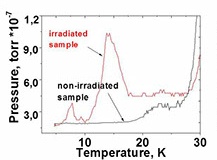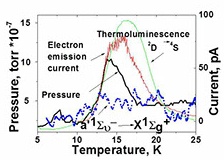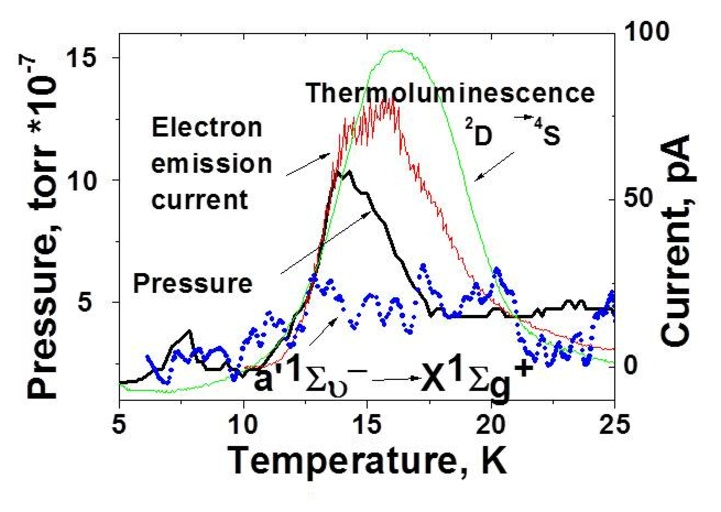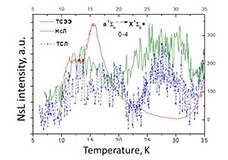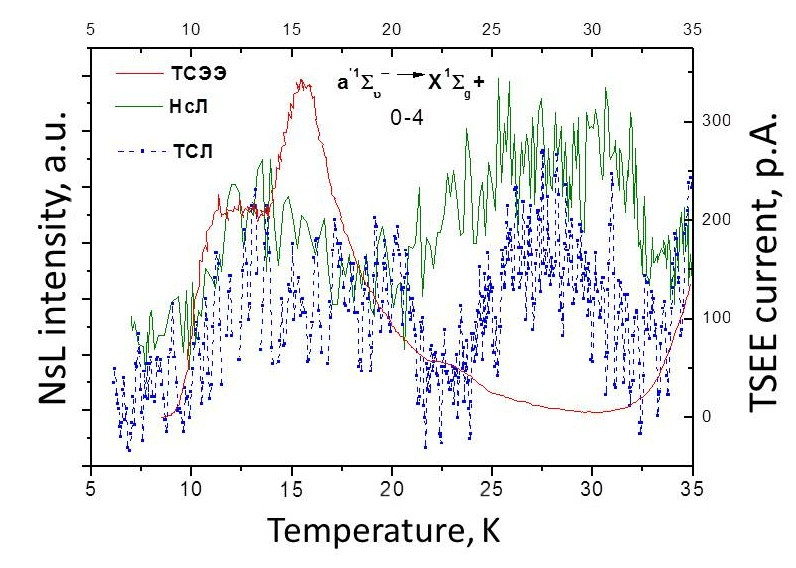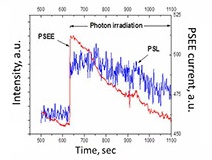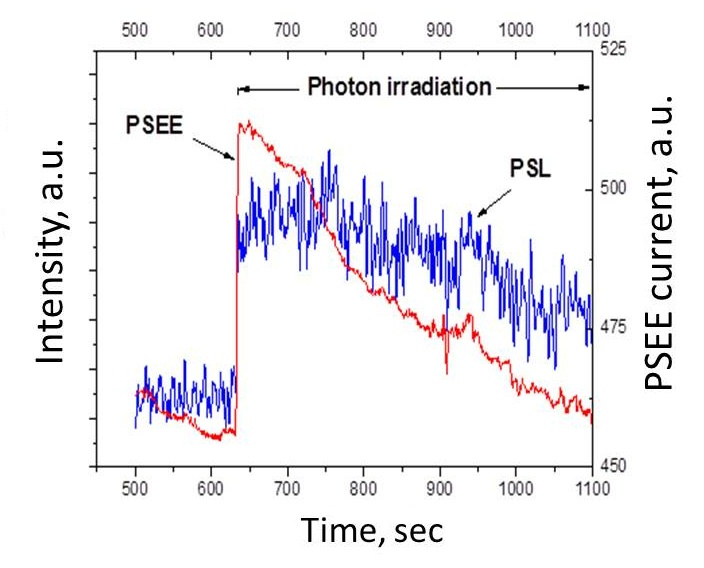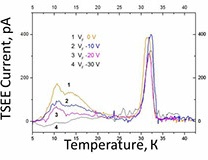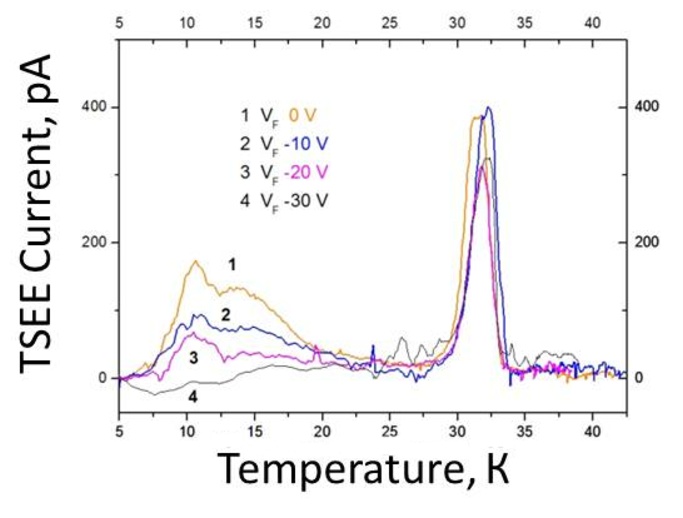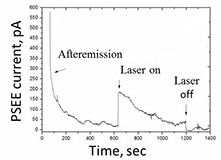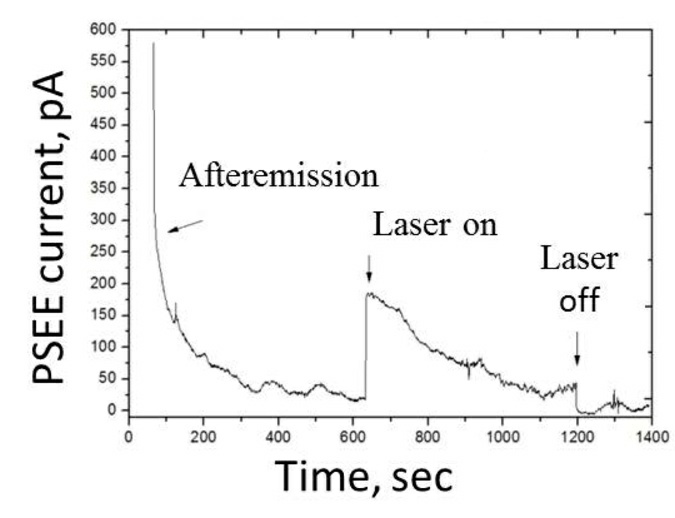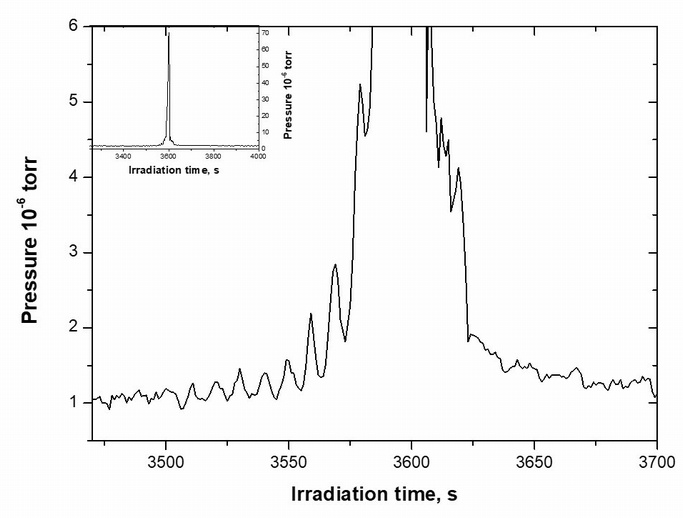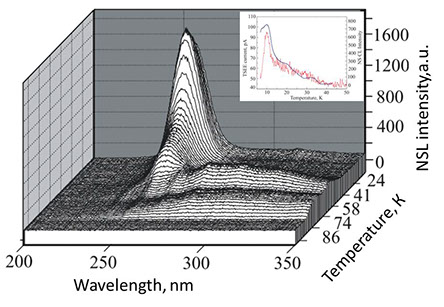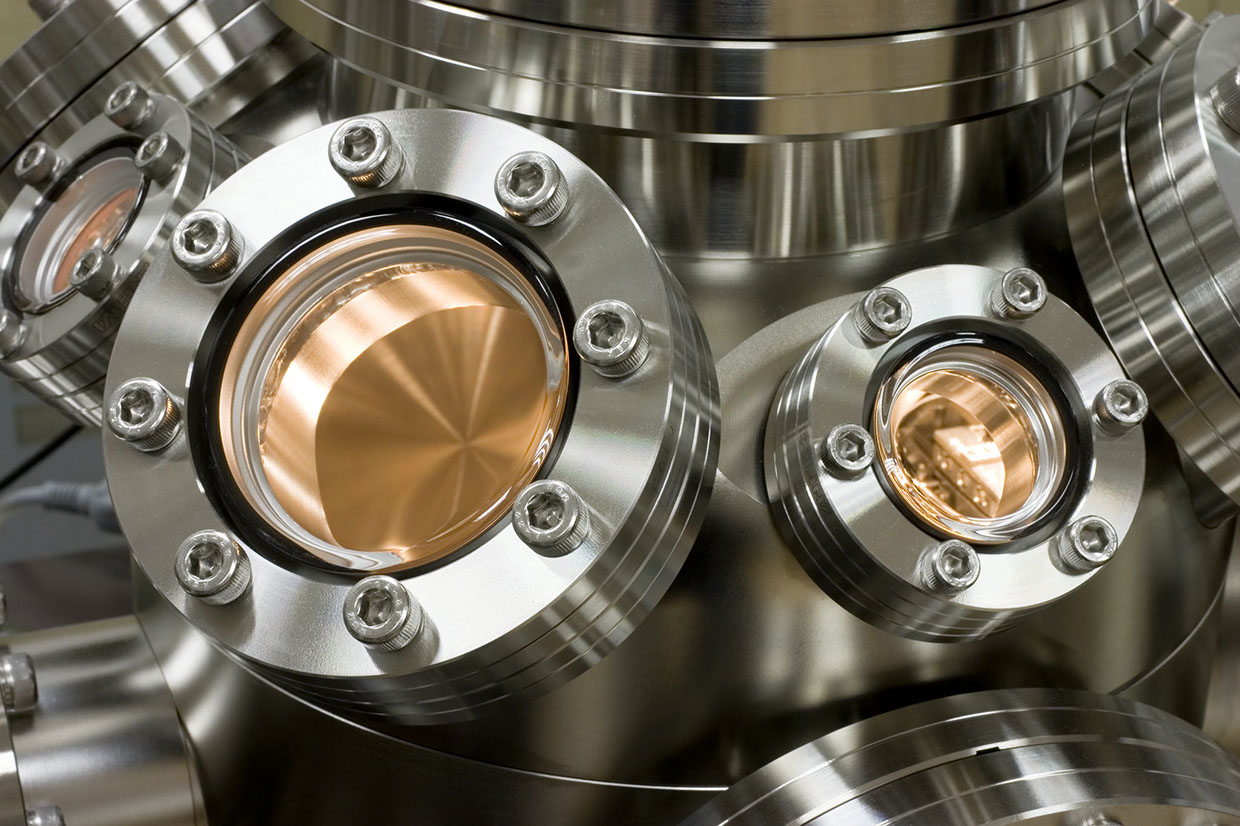
Research team for spectroscopy of atomic and molecular cryocondensates
Main research areas
● Excitonic states and processes of exciton and hole self-trapping;
● Mechanisms of electronically stimulated defect formation and desorption;
● Radiation effects, relaxation channels of electronic excitations and post-irradiation phenomena;
● Self-oscillation effects in cryogenic solids;
● Charge carriers in atomic and molecular cryocondensates – formation and stabilization of charge centers, reactions involving charge centers, relaxation
processes;
● Charge accumulation conditions and “frozen plasma” formation.
● New methods of charge states investigation in insulators;
Main investigation methods – optical and current spectroscopy
● Cathodoluminescence spectroscopy in a wide spectral range – from near infrared to vacuum ultraviolet;
● Correlated in time registration of thermoluminescence, electron emission and own particle emission;
● Correlated in time registration of optically-stimulated luminescence, electron emission and particle emission;
● Nonstationary luminescence;
● Matrix isolation;
● Low temperature radiation-induced absorption.
Main results
In rare gas solids doped with oxygen О– ions are formed under electron beam. Ions are neutralized by laser light. Thermally stimulated diffusion of oxygen atoms and their recombination lead to formation of excited molecules О2* emitting photons. This internal light source stimulates relaxation processes: luminescence of matrix, electron emission from the crystal surface and desorption of own particles.
A new channel of relaxation processes stimulated by chemiluminescent reactions is revealed
Thermoluminescence of solid nitrogen under step-wise heating.

A new phenomenon of anomalous low temperature emission of own particles from preliminary irradiated atomic and molecular cryocondensates is found. Its mechanism is based on conversion of electronic excitations energy into the kinetic energy of particles in course of neutralization reactions observed at temperatures much lower than the characteristic sublimation temperature.
N3+ + e- -> N*(2D) + N2 (1Σg+) + hv1+ ∆Е
N4+ + e- -> N2*(1Σu-) + N2(1Σg+) + hv2+ ∆Е
Comparison of desorption yields from preliminary irradiated and non-irradiated samples.
[IOP Conf. Series: Mater. Sci. Eng.169 (2017) 012007].
The same threshold for the yields of electrons thermoluminescence and desorption.
[Low Temp. Phys. 39 (2013) 446].
Anomalous low-temperature post-irradiation desorption of own particles from solid N2
Holes self-trapping in solid nitrogen with formation of N4+ centers is detected
Detection of products of electron-hole dissociative recombination reaction in the yields of nonstationary luminescence, thermoluminescence and photoluminescence is a proof of holes self-trapping, e.g., formation of N4+.
N4+ + e- -> N2* (a‘) + N2* (a‘)+ +ΔE1 -> N2 + N2 + 2hv + ΔE2
Comparison of relaxation emissions: thermoluminescence, exoelectron emission and nonstationary luminescence of solid nitrogen.
[J. Phys. Chem. A 119 (2015) 2475].
Photo-stimulated luminescence and exoelectron emission from solid nitrogen.
Possibility of “frozen plasma” creation in pre-irradiated cryocondesates of atomic and molecular gases is demonstrated for the first time. The concentration of charge centers reaches 1016 cm-3
An ultra high concentration of negative charge is achieved in dielectric films of solid nitrogen. Participation of N3- centers in the formation of electrostatic charge was revealed. It was shown that these centers play an important role in post-desorption, e.g., emission of particles from the surface of irradiated nitrogen films.
This effect has to be taken into account to ensure trouble-free operation of various vacuum devices under conditions of exposure to ionizing radiation, as well as elements of space equipment. This result also opens the possibility of creating a new type of charge accumulators and a wide range of high-tech applications.
Yield of thermally stimulated exoelectron emission with different extracting potentials.
Partial sample discharge and photon-stimulated detachment of electrons from N3- centers.
Delayed explosive emission of particles from solid methane and Ar matrices doped with CH4 under the action of an electron beam was revealed. Two types of self-oscillations with short and long periods were detected
Delayed particle emission is associated with the spontaneous release of energy that accumulates in radiation-induced defects until a critical concentration is reached. The release of energy is accompanied by a sharp rise in the temperature of solid methane or Ar matrix doped with CH4 and an outbreak of cathodoluminescence. For the first time, two types of self-oscillations of this emission were identified - long-term and short- term. Convincing evidence has been obtained that the generation of self-oscillations is due to instability in the system of methyl radicals and hydrogen atoms. It was found that the self-oscillations can be initiated in two ways – by external heating of the sample to release the stored chemical energy in recombination reactions, or by spontaneous release of the stored energy after reaching critical concentrations of radicals. The obtained results are of importance to solve a number of problems of nuclear physics (creation of effective cryogenic neutron moderators capable of working in the conditions of intense nuclear irradiation), space physics, astrophysics and biochemistry.
CH4 film 100 μ
Irradiated with an electron beam
1.5 kV; 3 mA during an hour.
Delay in the giant burst of particles with respect to the start of electron-irradiation indicates the need for the accumulation of radiolysis products for this effect. Short-period self- oscillations are visible against the background of a long-period flash.
CH4 – doped Ar matrix
Yield of optical emission – H band, in the range of pressure burst, temperature and pressure.
The correlated in real time study revealed a strong luminescence flash of the optical yields of H atoms (shown in Fig) and CH radicals which correlated with the surge temperature and explosive pulse of particle ejection.
New methods of charge states investigation – nonstationary luminescence and desorption, were developed
We have developed a new approach to the study of charge centers in irradiated solids. This original two-stage technique is based on controlled "injection" of electrons by their release from the traps under the action of sample heating. The investigated ion centers are first generated by an intense electron beam. Then, the formed centers are studied by recombination luminescence and desorption under the influence of a beam of low intensity in order to minimize the creation of new charge centers. The registration of nonstationary luminescence spectra and nonstationary desorption are performed under gradual heating of the irradiated sample for sequential release of electrons from deeper traps and their subsequent recombination with positively charged centers, which is manifested by their contribution to the nonstationary luminescence spectrum and yield of particles.
Nonstationary luminescence of (Xe2D)* center and its correlation with thermally stimulated exoelectron emission.
Key publications
E. Savchenko, I. Khyzhniy, S. Uyutnov, M. Bludov, V. Bondybey. Explosive desorption induced by radical–radical interaction in methane-doped Ar matrices, Nucl. Inst. Methods B 536 (1), 113 (2023).
DOI: 10.1016/j.nimb.2023.01.005.
M. Bludov, I. Khyzhniy, S. Uyutnov, E. Savchenko, Matrix-Assisted Processes in CH4-Doped Ar Ices Irradiated with an Electron Beam, Methane, 2(4), 372 (2023)
DOI: 10.3390/methane2040025.
E. Savchenko, I. Khyzhniy, S. Uyutnov, M. Bludov, A. Ponomaryov, V. Bondybey. Radiation-induced phenomena in thermally treated Kr matrices, Low Temp. Phys. 49 (5), 574 (2023).
DOI: 10.1063/10.0017819.
I.V. Khizhny, S.A. Uyutnov, M.A. Bludov, E.V. Savchenko. Explosive desorption of solid methane particles induced by an electron beam, Low Temp. Phys. 44, No. 11, 1223 (2018).
DOI: 10.1063/1.5062166.
E. Savchenko, I. Khyzhniy, S. Uyutnov, M. Bludov, A. Barabashov, G. Gumenchuk, V. Bondybey. Radiation effects in nitrogen and methane “ices”, Nucl. Instrum. Methods Phys Res., Sect. B 435, 38-42 (2018).
DOI: 10.1016/j.nimb.2017.10.014.
E.V. Savchenko, I.V. Khyzhniy, S.A. Uyutnov, M.A. Bludov, A.P. Barabashov, G.B. Gumenchuk, V.E. Bondybey. Excitation-induced processes in model molecular solid – N2. J. Lumin. 191, Part A, 73-77 (2017).
DOI: 10.1016/j.jlumin.2016.12.055.
E. Savchenko, I. Khyzhniy, S. Uyutnov, M. Bludov, A. Barabashov, G. Gumenchuk, V. Bondybey. Radiation-induced defects, energy storage and release in nitrogen solids, IOP Conf. Ser.: Mater. Sci. Eng. 169, Conf. 1, 2017, 012007 (2017).
DOI: 10.1088/1757-899X/169/1/012007 // PDF (open access).
E. Savchenko, I. Khyzhniy, S. Uyutnov, M. Bludov, G. Gumenchuk and V. Bondybey. Defect-induced electrostatic charging of nitrogen films, Phys. Stat. Solidi B, 253, No. 11, 2115 (2016).
DOI: 10.1002/pssb.201600406.
E. Savchenko, I. Khyzhniy, S. Uyutnov, M. Bludov, G. Gumenchuk, V. Bondybey. Emission spectroscopy of solid nitrogen, Radiat. Meas. 90, No. 1, 1 (2016).
DOI: 10.1016/j.radmeas.2015.12.044.
E. V. Savchenko, I. V. Khyzhniy, S. A. Uyutnov, A. P. Barabashov, G. B. Gumenchuk, M. K. Beyer, A. N. Ponomaryov, and V. E. Bondybey. Radiation effects in solid nitrogen and nitrogen-containing matrices: Fingerprints of N4+ species, J. Phys. Chem. A 119, No. 11, 2475 (2015).
DOI: 10.1021/jp5087575.
E. Savchenko, I. Khyzhniy, S. Uyutnov, A. Barabashov, G. Gumenchuk, A. Ponomaryov and V. Bondybey. Charged defects and defect-induced processes in nitrogen films, Phys. Stat. Solidi C, 12, No 1-2 , 49 (2015).
DOI: 10.1002/pssc.201400166.
E.V. Savchenko, I.V. Khyzhniy, S.A. Uyutnov, A.N. Ponomaryov, G.B. Gumenchuk, V.E. Bondybey. Nonstationary luminescence as a probe of charged species, Phys. Procedia, 76, No. 1, 111 (2015).
DOI: 10.1016/j.phpro.2015.10.021.
E.V. Savchenko, I.V. Khyzhniy, S.A. Uyutnov, A.N. Ponomaryov, G.B. Gumenchuk and V.E. Bondybey. Anomalous low-temperature “post-desorption” from solid nitrogen, FNT 39, 574-579 (2013) [Low Temp. Phys. 39, 446-450 (2013)].
DOI: 10.1063/1.4807046.
E. V. Savchenko, I. V. Khyzhniy, S. A. Uyutnov, G. B. Gumenchuk, A. N. Ponomaryov, M. K. Beyer, V. E. Bondybey. Charging effects in an electron bombarded Ar matrix and the role of chemiluminescence-driven relaxation, J. Phys. Chem. A 115, No. 25, 7258 (2011).
DOI: 10.1021/jp2004419.
E.V. Savchenko and Yu.A. Dmitriev. “New Aspects of Relaxation Processes in Cryogenic Solids”, in Applied Physics in the 21st Century (Horizons in World Physics. Volume 269) Ed. Raymond P. Valencia, Nova Science Publishers New York, 2010, p. 113-162
I.V. Khyzhniy, E.V. Savchenko, S.A. Uyutnov, G.B. Gumenchuk, A.N. Ponomaryov, V.E. Bondybey. Exoelectron emission from solid nitrogen, Radiation Measurements 45, No. 3-6, 353 (2010).
DOI: 10.1016/j.radmeas.2009.11.020.
E.V. Savchenko, G. Zimmerer, V.E. Bondybey. Electronically induced modification of atomic solids and their relaxation probed by luminescence methods, J. Luminesc. 129, 1866 (2009).
DOI: 10.1016/j.jlumin.2009.01.040.
I.V. Khyzhniy, S. A. Uyutnov, E.V. Savchenko, G.B. Gumenchuk, A.N. Ponomaryov, V.E. Bondybey. Electron traps in solid Xe, FNT 35, №. 4, 433 (2009) [Low Temp. Phys. 35, No. 4, 335 (2009)].
DOI: 10.1063/1.3117964.
H. Tanskanen, L. Khriachtchev, A. Lignell, M. Räsänen, S. Johansson, I.V. Khyzhniy, E.V. Savchenko. Formation of noble-gas hydrides and decay of solvated protons revisited: diffusion-controlled reactions and hydrogen atom losses in solid noble gases, Phys. Chem. Chem. Phys., 10, 692 (2008).
DOI: 10.1039/B713212C.
I.V. Khyzhniy, O. N. Grigorashchenko, A.N. Ponomaryov, E.V. Savchenko, V.E. Bondybey. Thermally stimulated exoelectron emission from solid Xe, FNT 33, No. 6-7, 701 (2007) [Low Temp. Phys. 33, No. 6, 529 (2007)].
DOI: 10.1063/1.2746244.
E.V. Savchenko, A.N. Ogurtsov, I.V. Khyzhniy, G. Stryganyuk, G. Zimmerer. Creation of permanent lattice defects via exciton self-trapping into molecular states in Xe matrix. Phys. Chem. Chem. Phys. 7, 785 (2005).
DOI: 10.1039/B415247F.
E.V. Savchenko, G.B. Gumenchuk, E.M. Yurtaeva, A.G. Belov, I.V. Khyzhniy, M. Frankowski, M.K. Beyer, A.M. Smith-Gicklhorn, A.N. Ponomaryov, V.E. Bondybey. Anomalous low temperature desorption from preirradiated rare gas solids, J. Luminesc. 112, 101 (2005).
Last updated: 03/08/2025
Contacts
47 Nauky Ave., Kharkiv, 61103, Ukraine
tel.: +380(57)341-0918
fax: +380(57)340-3370
© 2017-2025, Design by Anton Klimkin
Executive editor: V.A.Gudimenko
v.2024.2.10



